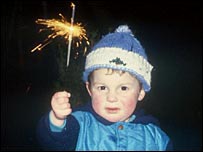Take Away English-Bonfire night 焰火之夜(在线收听)

Child with a sparkler
|
That rhyme is repeated by children in Britain to remember why, every year on 5th November, many British people celebrate Bonfire Night.
They might celebrate at home in their gardens, by building a bonfire and letting off fireworks. Young children like to light sparklers and wave them.
There are also many organised firework displays in public areas – a huge bonfire is built and there will usually be a long firework display with big, colourful fireworks like bangers, rockets, and Catherine wheels.
This festival falls in Autumn when the weather is quite cold, so people watch the fireworks and eat hot food to keep them warm – hot dogs or jacket potatoes for example and you might drink mulled wine or hot chocolate.
So why do British people do this? Well, on November 5th, 1605, a man called Guy Fawkes tried to blow up the British Houses of Parliament with gunpowder.
He wanted to get revenge on the King at that time for his lack of tolerance towards Catholics. However, the plot was discovered and Guy Fawkes was caught and executed for treason.
It was then that the tradition of Bonfire Night began. People started to have bonfires to celebrate the safety of the King because he wasn’t blown up. November 5th is also known as Guy Fawkes’ Night.
People would burn effigies of Guy Fawkes and even today, people make dummies of Guy Fawkes to burn, which are called ‘the Guy’. Children still wheel their dummies through the streets, knocking on people’s doors and asking for ‘a penny for the Guy’ to earn some money.
The origins of the festival have much less importance today but it remains a fun and exciting night for children and adults alike. But if you’re lighting fireworks, then be careful!
|
GLOSSARY 词汇表 |
|
|
gunpowder bonfire sparklers hot dogs mulled wine Houses of Parliament lack of Catholics executed dummies |
treason letting off firework display jacket potatoes blow up to get revenge on tolerance plot effigies to wheel |